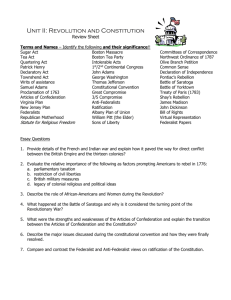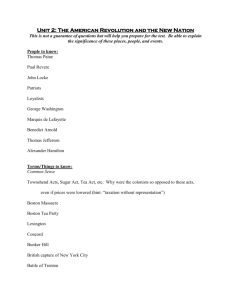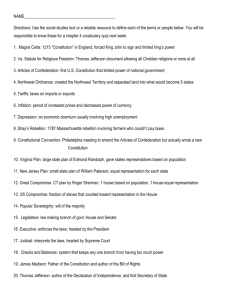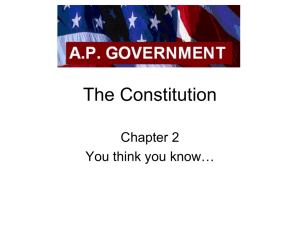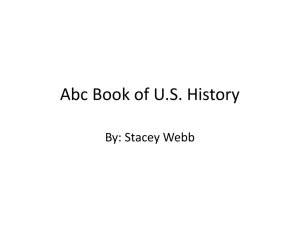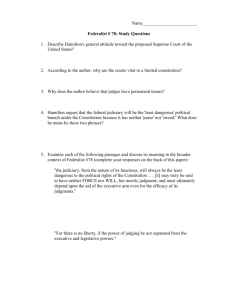U.S. History EOCT test
advertisement
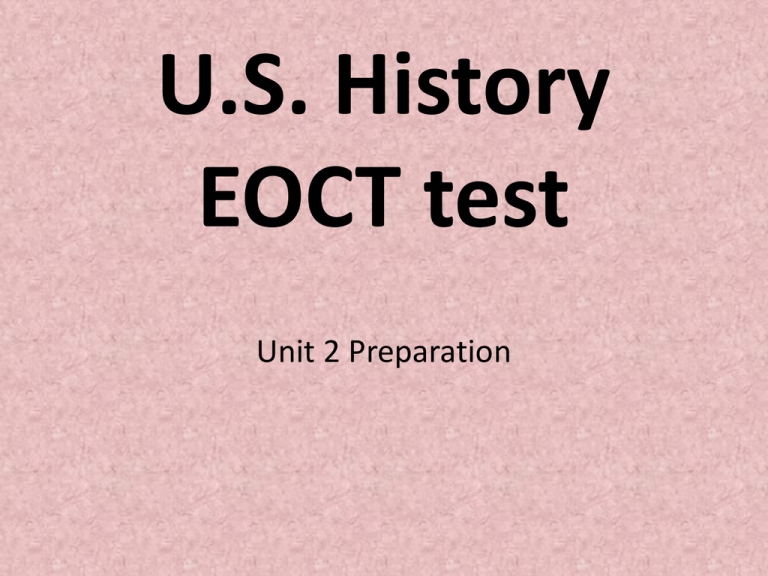
U.S. History EOCT test Unit 2 Preparation SSUSH 4 4a Explain the language, organization, and intellectual sources of the Declaration of Independence; including the writing of John Locke and the role of Thomas Jefferson. Declaration of Independence • Explanation to Americans and other countries as to why the colonist had no choice but to break away from Great Britain. • In this document Thomas Jefferson lists all the unfair practices that Britain placed on the colonist. Thomas Jefferson • Wrote the Declaration of Independence • Was influenced by John Lock. • Social Contract Theory Declaration of Independence • Written mainly by Thomas Jefferson • In 1776 • Declared American Independence from England • Main Ideas taken from John Locke’s “Social Contract” Theory “Natural Rights” • “We hold these truths to be self evident, that all men are created equal, that they are endowed by their creator with certain unalienable rights, that among these are Life, Liberty and the pursuit of happiness.” John Locke • Social Contract theory influenced Thomas Jefferson’s writing the Declaration of Independence. • Protection of Life, Liberty, and Property is government’s job. Theme Ideals & Beliefs – Social Contract. Declaration of Independence • John Locke believed that if a government failed to protect its citizens rights and instead oppressed them, the citizens had a right to overthrow the government and create a new one. Baron de Montesquieu Wrote : Spirit of the Laws • Separation of Powers • Checks and Balances 4b Explain the reason for and significance of the French Alliance and foreign assistance and the roles of Benjamin Franklin and the Marquis de Lafayette Benjamin Franklin • Ambassador to France. • Helped the United States make foreign alliance with France. • Was effective in getting French assistance(help). French Conditions • United States must show that it has the ability to win the war. • France did not want to have to have total responsibility in winning the war against Great Britain. Marquis de Lafayette • Young French aristocrat who experienced the hardships at Valley Forge as he camped with George Washington. • Was instrumental in getting French reinforcements. • Created the strategy to win the Battle of Yorktown (the last battle in the war) Helped Benjamin Franklin get French support Marquis de Lafayette Planned the Battle of Yorktown & Capture of General Cornwallis Served as Military Aid to General George Washington & wintered at Valley Forge Battle of Saratoga • Called the turning point of the American Revolution • because the success of the colonists, even though outnumbered, convinced France to send aid like ships and guns to colonists. • 1st time united States given Diplomatic Recognition by a foreign country. Theme Conflicts & Compromise – American Revolution. Benjamin Franklin & Marquis de Lafayette Battle of Saratoga French sent ships, supplies, Soldiers 4c Analyze George Washington as a military leader; include the creation of a professional military and the life of a common soldier, and describe the significance of the crossing of the Delaware River and Valley Forge. Continental Army • Commanded by George Washington • Fought the British during the Revolutionary war. Leadership of George Washington • Washington lost many Battles prior to the Battle of Trenton. • Had Farmers, frontier hunters, not a well trained military. • Many deserted under heavy fire from the enemy. • There was no money for weapons, gunpowder, clothing, and other supplies. Leadership of George Washington con… • George Washington is considered a great American because he overcame great odds and difficulties to help the U.S. win the Revolutionary War. Militia • Volunteer colonist who fought against the British • Their use of hit and run tactics were instrumental in winning the war. Valley Forge • Lowest point for the Continentals during the Revolutionary War. • Soldiers starved, experienced harsh winter, and went without adequate clothing or shelter. Baron Frederick von Steuben • Drilled Washington's soldiers to make them into a more professional army. Von Steuben Drilling Soldiers Battle of Trenton • New Jersey • Washington crossed the Delaware river and caught the British and German Hessians by surprise. • This victory was a much needed morale boost for the Continentals. Crossing the Delaware Significance Battle of Trenton • Victory after a long series of defeats. • Boosted Morale of the Soldiers! • Gave them great Pride that they could win the war! 4d Explain the role of geography at the Battle of Yorktown, the role of Lord Cornwallis, and the Treaty of Paris 1783. Marquis de Lafayette • Young French aristocrat who experienced the hardships at Valley Forge as he camped with George Washington. • Was instrumental in getting French reinforcements. • Created the strategy to win the Battle of Yorktown (the last battle in the war) Battle of Yorktown, 1781 • General Lord Cornwallis was surrounded and trapped by colonial and French troops. Lord Cornwallis • Commander of the British Army. • Trapped and forced to surrender at the Battle of Yorktown in 1781. Treaty of Paris 1783 • Ended the Revolutionary War • Great Britain forced to acknowledge U.S. independence. SSUSH 5 5a Explain how the weaknesses in the Articles of Confederation and Daniel Shay’s Rebellion led to a call for a stronger central government. Articles of Confederation • The first form of government for the newly formed united states • Gave too little power to congress (could not tax or enforce laws) • The State’s kept their power and authority Shay’s Rebellion • An uprising of debt-ridden Massachusetts farmers protesting increased state taxes in 1787. • The states began to realize that a stronger central government was needed. • They decided to send delegates to revise the Articles of Confederation but decided to write a new Constitution. Weaknesses of the Articles of Confederation Provoked a need for Stronger Government Could Not Tax No President 9 of 13 to Pass Laws No National Courts All 13 to Amend Weakness in Articles of Confederation Example Change in Constitution No Standing Army In ability to deal with the threat of "Shay's Rebellion" Federal Government is given the power to raise and maintain a standing army No Federal Taxation States did not pay debts to Congress and so federal gov't had no $$ Congress is granted the power to tax, impose duty and raise tariffs No Single National Currency States minted money, no set exchange disrupted trade among the states Congress is granted sole power to coin money No Executive Leadership Failure of direct leadership resulted in indecision A strong executive (President) is created Each State had Equal Vote in Congress Smaller states with low populations had disproportional power Bicameral Legislature with proportional representation in the House of Reps. Required Unanimous Vote to Amend Complete inability to correct the failures under the articles The 1787 Constitutional Convention completely replaced the Articles rather than amending them Need for stronger Government! Constitutional Convention 5b Evaluate the major arguments of the anti-federalists and the Federalists concerning form of government, factions, checks and balances, and the power of executive, including the roles of Alexander Hamilton and James Madison. Baron de Montesquieu Wrote : Spirit of the Laws • Separation of Powers • Checks and Balances James Madison • Known as the “Father of the Constitution” • Delegate to the constitution convention from Virginia • Proposed the Virginia Plan • Also introduced a plan for sharing power between the national Government and the state governments. FEDERALISM Federalism Concurrent Powers Delegated Powers Reserved Powers 5c Explain the key features of the Constitution, specifically the Great Compromise, separation of powers (influence of Montesquieu), limited government, and the issue of slavery. Arguments at the Constitutional Convention The most heated argument at the Constitutional Convention was over the issue of state representation would be determined in the new Legislative branch? Essential Question How would each state be represented in the Legislative branch of the new government? Virginia Plan • Two House Legislature based on each state’s population • Bicameral Legislature New Jersey Plan •One House Legislature with equal representation. •Unicameral Legislature Connecticut Plan “Great Compromise” • Resolved the conflict between the Virginia Plan and the New Jersey Plan • Created a Bicameral Legislature (two houses). • House of Representatives – representation based on Population • Senate – based on equal representation. Two per state Slavery Issue Would slaves be counted into the population in determining state representation for the House of Representatives? Would slaves be counted into the Census that happens every ten years? Slavery Issue • Would the States control the slave trade? -Or• Would the National government control the slave trade? Power of the Executive • Should the States elect the President? • Should the people elect the President? • Should Congress elect the President? Federalist & Antifederalist Argue Over Ratification (approval) of U.S. Constitution Federalist • Believed the country would not survive without the strong central government. • Published the “Federalist Papers” • James Madison, John Jay, and Alexander Hamilton Anti-Federalist • Believed the constitution gave too much power to the national government and that it failed to provide a Bill of Rights to guarantee protection to the People • Demanded a Bill of Rights! Patrick Henry, an anti – Federalist is known for 2 quotes “Give me Liberty or Give me death!” “I believe I smell a rat!” Bill of Rights • 1st ten Amendments to the Constitution • Added in 1791 because the Anti-federalists insisted at list of rights be added before the constitution could be ratified. • Bill of Rights protects individual rights! The Constitution • Begins with “We the People” • Created the federal system of government / “The Supreme Law of the Land” • Created a Republic • A Republic is a government in which the people elect representatives to carry out the work of government. Organization of the Constitution • Preamble – Introduces the constitution by listing the six goals of the document. • Seven Articles • The first 3 set up the Three Branches of government. 5d Analyze how the Bill of Rights serves as a protector of individual and state’s rights. Bill of Rights • 1st ten Amendments to the Constitution • Added in 1791 because the Anti-federalists insisted at list of rights be added before the constitution could be ratified. • Bill of Rights protects individual rights! The Bill of Rights • 1st Amendment • Freedom of religion, speech, press, assembly and petition The Bill of Rights • 2nd Amendment • Right to Bear arms The Bill of Rights • 4th Amendment • Rights against illegal Searches and Seizures • “Privacy Amendment” Bill of Rights • 5th Amendment • Rights of the Accused • No person shall be held to answer for a capital, or otherwise infamous crime, unless on a presentment or indictment of a Grand Jury . . . nor shall any person be subject for the same offence to be twice put in jeopardy of life or limb; nor shall he be compelled in any criminal case to be witness against himself, nor deprived of life, liberty,or property, without due process of law. . . . — Fifth Amendment A P P S 3 Based on Issued by an Probable Cause Impartial Judge Search Warrant Name the Person, Place, and Item to be searched for. Must be a reasonable Search & Seizure 5e Explain the importance of the Presidencies of George Washington and John Adams; include the Whiskey Rebellion, non-intervention in Europe, and development of political parties (Alexander Hamilton). George Washington • Presided over the Constitutional Convention • Overcome many obstacles during the Revolutionary War and is considered a great military leader. Whiskey Rebellion • Unlike shay’s rebellion that showed the country needed a strong central government, • This rebellion showed the country that the government we formed under the U.S. Constitution was strong. • George Washington used 13,000 troops to enforce the Whiskey tax. Two Term Presidency • George Washington only served for two terms in office. • One term is four years. • Two terms is Eight years • Every president from George Washington to Franklin Delano Roosevelt served no more than eight years. • FDR was elected to 4 terms (died in the 4th) • 22nd Amendment limits Presidents to 2 terms. Farewell Address 1. George Washington kept the U.S. neutral during conflicts between Britain and France. • Washington warned against entangling alliances . • Thought the Country needed time to grow. 2. George Washington also warned against creating Political Parties (Factions). • The country could possibly fight within and weaken the country or have a civil war. Non-intervention in Europe • George Washington warned the U.S. not to side with Great Britain or France. • The young country needed to stay out of other countries wars. Federalist Era John Adams – Alien & Sedition Acts • Second President of the U.S. • Passed a series of laws where U.S. citizens were put in prison and their property seized if spoke out against government. • Many considered a violation of 1st amendment freedom of speech and press. VA & KY Resolutions • Written by Thomas Jefferson and James Madison • Rebuked the Alien & Sedition Acts as unconstitutional because violated 1st amendment. • Nullification theory – a state may declare a federal law null and void if it is unconstitutional. Rise of Political Parties • John Adams’ secretary of treasury Alexander Hamilton becomes the leader of the FEDERALIST PARTY • Thomas Jefferson becomes the leader of the DEMOCRATIC-REPUBLICAN PARTY. “XYZ” Affair • Led to an undeclared war with France • Three French agents, originally called X, Y, and Z, demanded a large cash bribe for the delegation to speak to the French foreign minister • huge loan to help fund the French wars as a condition for continuing negotiations SSUSH 6 6a Explain the Northwest Ordinance’s importance in the westward migration of Americans, and on slavery, public education, and the addition of new states. Northwest Territory • States fought over this land area for ownership. • Gave land claims to the U.S. government. • Congress passes 2 laws to control development and settlement. Land Ordinance of 1785 • Establishes definite boundary lines so there would be no confusion over land ownership. • Surveyed the land to sale to citizens to populate. Public Education • One Township was sold off to finance and support public education. • Townships encouraged to establish public schools. Northwest Ordinance of 1787 • Established process that territories could use to become a state. 1. Set up temp gov’t. 2. 5,000 people elect rep. to legislature. 3. 60,000 could apply for statehood. Northwest Ordinance effect on Slavery • Outlawed slavery in the Northwest Territory. • Settlers guaranteed freedom of Religion, freedom of speech, and other rights.
